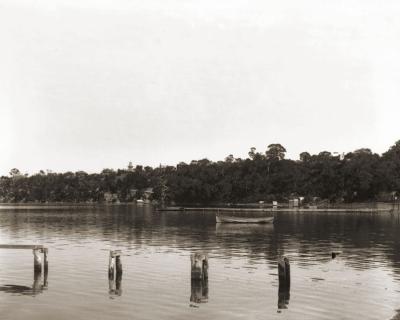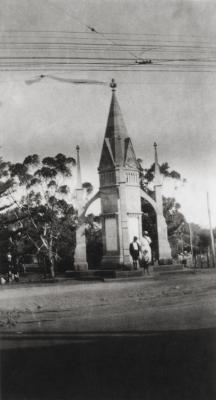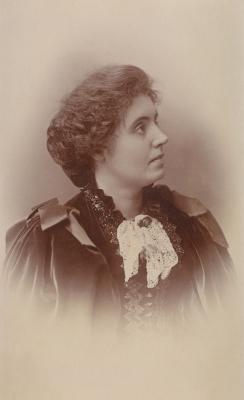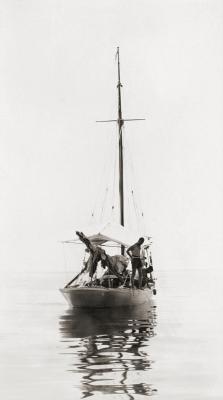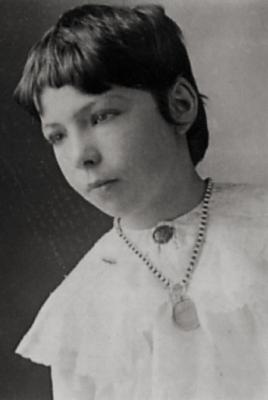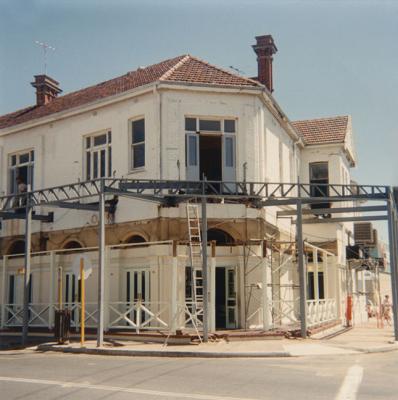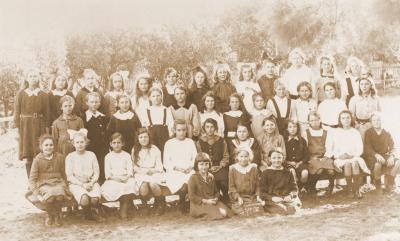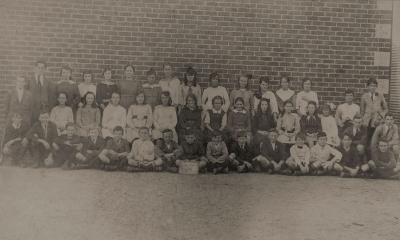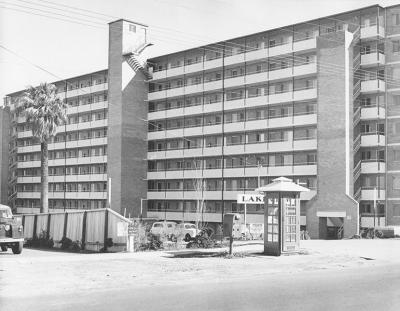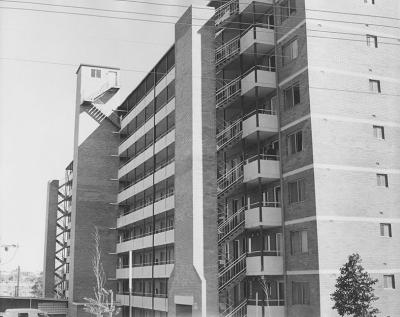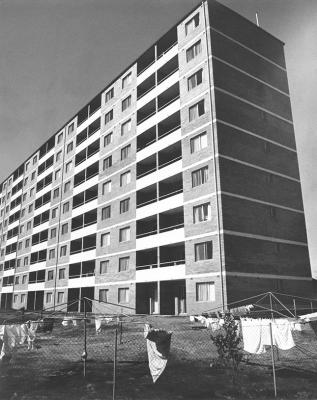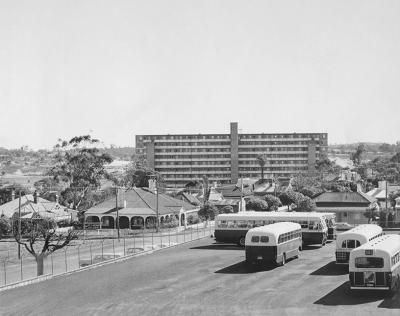Claremont Jetty, Freshwater Bay
Chester Road in foreground leading to the Claremont Jetty. A small building to the left of the jetty. A wide ferry berth at the end of the jetty. Boat pens and a walkway to the boat hire on right. Freshwater Bay is in the background.
Invitations to tender went out in January 1897, to build a jetty in Claremont. There must have been something already built on that site as the tender requested a jetty 100 feet long and to remove and re-erect an existing bathing shed and gangway. Mr Matthew Canali was awarded the work which would total £1000.
The Jetty was completed in November of 1897 near the foot of Bay View Terrace for the purpose of both business (in the form of cargo deliveries) and pleasure. Perhaps too much pleasure, as shortly after its completion newspaper articles were printing stories regarding ‘the indecent conduct of certain individuals’ which ‘practically closes the jetty to females’. A call was made to enforce a regulation which stated no person shall bathe within 500 feet of any jetty, wharf, pier or landing place after 7am and before 8 pm and that Constable Huxtable (who lived in what is now the museum building) was asked to enforce this regulation as well as enforcing the need for patrons to wear bathing costumes.
As well as individual bathers, The Claremont Amateur Swimming club began at the Claremont Jetty and continued to hold their practices there until the Baths were built. Carnivals were held on the foreshore next to the jetty while spectators crowded on it.
Day trippers would either use their own boats or come on the ferry to the Claremont Jetty and walk up the hill to the Continental Hotel for refreshments.
In summer months, the jetty was frequently thronged with happy groups waiting to board a river ferry for a shilling (adults) or sixpence (children). Bands would be set up at the end to give the passengers a musical send-off.
The River Queen took families and school groups up the river to Point Walter for picnics. At night, the Emerald or Zephyr (2 decks high with enclosed canopy top) would pull up at the jetty with lights blazing and a dance band playing and to pick up passengers for a cruise along the river.
During the Railway strike in 1921 the Zephyr and the Westralian ran a ferry service between several towns along the river including Claremont and the city. This combined with a special bus route from Claremont prompted a journalist from the West Australian to say ‘the residents of Claremont are generally much better off than those in many other places”.
Prior to World War II the Emerald carried blue metal to Rottnest for the construction of concrete gun emplacements. Sheep were occasionally off-loaded here and driven up Bay View Terrace to the Showgrounds.
Entrepreneurs often tried their hands at making money on the jetty. In September 1953, skippers of the 130 ton Villaret moored alongside the Claremont jetty and sold snap frozen fish caught in Shark Bay at cheaper than retail prices. They sold 15,000 pounds of fish in a single weekend!
The most popular business at the jetty was of course the boat hire business. The first one set up was in 1901 possibly by Alfred Tilley who was the first boat builder registered in Claremont. Shortly after it was taken over by Mr JJ Vick who made it incredibly popular.
The WA Record 1903 - Anyone who gets on the wharf has only to see Mr Vick he will fix them up with a good boat and all requisites - a man in the right place - a real jolly sort.
Eventually in 1904, Mr Vick wanted to expand his business and was granted the right to erect a refreshment room on the foreshore near the jetty. His business also included a staging fitted for rollers for boat-owners to pull up their boats in order to make repairs. He provided tackle and chairs to be rented on an hourly rate.
This business was eventually taken over by George Cooper who had bought the property and boat shed at 8 Victoria Avenue (now part of the Claremont Museum).
After George’s death it was owned/leased by Harry Buckland, then Lew Armstrong and Mrs Wibberly who ran the business from 1943-1952. Its slightly unclear if people owned this business or just leased it as a newspaper account says that in 1950 it was owned by the Harbour and Lights Department. The article goes on to say that the Council wanted the building demolished as it had no sanitary services and kitchen waste would go directly into the river. Residents of the structure had to walk to the nearby hotel to use the facilities. The Council went as far as applying to the Health Department to have the structure condemned, however this may not have happened as Ken and Frank Sawkins went on to run the business until 1963. It was finally demolished after they left.
The constant use of the jetty meant that by the 1940s, it was suffering from a lack of maintenance. Several people had fallen through a particularly large gap in the planks which prompted W S Andrew, Undersecretary for Works to post a sign on the jetty that read : Warning Notice: Persons using this jetty do so at their own risk. Mayor Gillet labelled it a “menace to Claremont” while newspapers called it a death-trap. The disrepair eventually led to the death of 67-year-old Gregory Prenderville who fell through the hole and drowned in the river below. It seems that the Public Works Department and the Municipality of Claremont could not agree as to who was responsible for the repairs/cost. Mr Symonds, proprietor of the Continental Hotel claimed it should be the responsibility of the Military as it was servicemen being brought to and embarking from the Claremont Jetty who dropped their lit cigarettes causing patches of the wooden structure to burn. The Council took on some resurfacing repairs in 1945.
However, by 1950, a burnt-out gap 15 feet long by 18 inches wide appeared and It was through this hole that 3-year-old Raymond John Bodinner slipped through and drowned. The debate began again as to who was responsible for repairs. But by the end of that year the jetty underwent extensive repairs by the Harbour and Rivers Department at a cost shared equally by the Claremont Council and the Public Works Department. These works included re-decking, handrails, electric lights and a public convenience on the foreshore.
By the late 1980s the jetty had deteriorated beyond repair and in 1991 the structure was removed and a new jetty was constructed. At the official re-opening a piano at the end of the jetty was played by a member of the Sawkins family (the last boat hire people).
Details
Details
Copyright and Reference
Copyright and Reference
Acknowledgements to be made to 'Claremont Museum 04.308a'.
More items like this
Other items from Town of Claremont Museum
- Claremont War Memorial
- Building Workers At Claremont Hospital For The Insane
- Harriett Mary Ann Dawe
- Yacht 'Genesta' At Rest
- Eileen Buckland
- Hotel Claremont Restoration
- Claremont Central School Std V 1918
- Claremont Central School Std VII 1920
- 'Lakeview', 34 Davies Road, Claremont
- 'Lakeview', 34 Davies Road, Claremont
- 'Lakeview', 34 Davies Road, Claremont
- MTT Bus Depot, Davies Road, Claremont
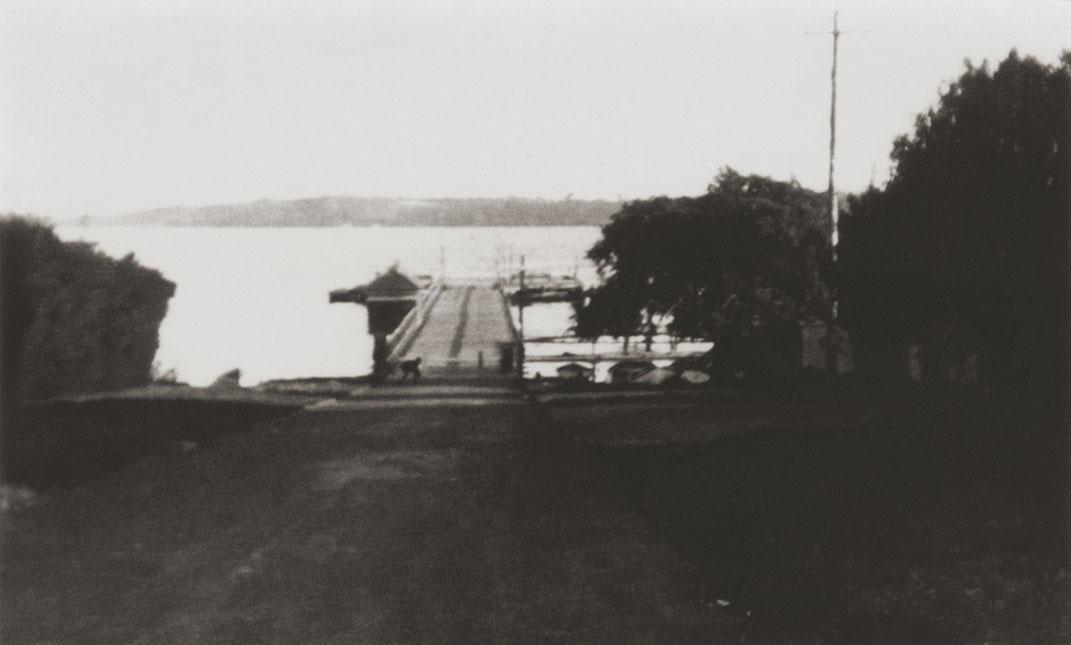
Source: Claremont Museum 04.308a
Scan this QR code to open this page on your phone ->



